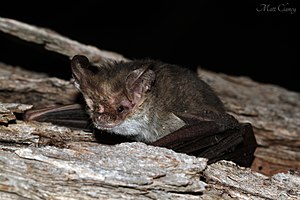Australian long-eared bats
| Australian long-eared bats | ||||||||||||
|---|---|---|---|---|---|---|---|---|---|---|---|---|

Nyctophilus geoffroyi |
||||||||||||
| Systematics | ||||||||||||
|
||||||||||||
| Scientific name | ||||||||||||
| Nyctophilini | ||||||||||||
| Peters , 1865 |
The Australian long-eared bats (Nyctophilini) are a group of bats from the smooth-nosed family (Vespertilionidae). This group includes around twelve species from two genera, Nyctophilus and Pharotis , which live in Australia , New Guinea and New Caledonia . But one or two species are extinct.
description
These animals differ from all other smooth noses in that they have a small nosepiece that sits on the cut-off snout. The ears are long and grown together at the base. The color of their fur varies from orange to light brown to gray. With a head body length of 38 to 75 millimeters and a weight of 4 to 20 grams, they belong to the small to medium-sized species.
Way of life
These animals inhabit a variety of habitats including forests, bushy areas, and deserts. Caves, crevices and tree hollows serve as sleeping places, sometimes also buildings. They sleep alone, in pairs, or in smaller groups, like most bats they are nocturnal. At night they go in search of food, their flight being described as slow and fluttering. Their food consists of insects that they either prey on in flight or collect from leaves. They hibernate in the cooler regions of their range.
Little is known about reproduction; species that hibernate often mate in autumn, but fertilization does not occur until spring. The birth of the mostly two young animals occurs in late spring or summer.
Systematics and types
In some systematics the Australian long-eared bats are listed as a separate subfamily, Nyctophilinae, in others they are assigned to the actual smooth-nosed bats (Vespertilioninae). They are likely to be closely related to the Antrozoinae .
There are two genera, Nyctophilus and Pharotis , with around 12 species, including one or two extinct:
- Nyctophilus arnhemensis isnative tonorthern Western Australia and the Northern Territory .
- Nyctophilus bifax lives in New Guinea and northern Australia.
- Nyctophilus geoffroyi is common across Australia.
- Nyctophilus gouldii is native to all of southern Australia.
- Nyctophilus approach is endemic to Lembata Island, which is part of the Lesser Sunda Islands . The species is considered threatened.
- Nyctophilus howensis was previously found on Lord Howe Island , but is believed to have become extinct around 1500.
- Nyctophilus microdon lives in eastern New Guinea.
- Nyctophilus microtis is also native to New Guinea.
- Nyctophilus nebulosus was only discovered in the 1990s. The species lives in New Caledonia .
- Nyctophilus timoriensis lives across Australia, New Guinea and possibly Timor as well .
- Nyctophilus walkeri lives in northern Western Australia and the Northern Territory.
- Pharotis imogene lives in southeastern New Guinea. It is known as the Lazarus taxon and was not sighted between 1890 and 2012. The IUCN lists them in the critically endangered category.
Web links
literature
- Ronald M. Nowak: Walker's Mammals of the World . Johns Hopkins University Press, 1999 ISBN 0-8018-5789-9